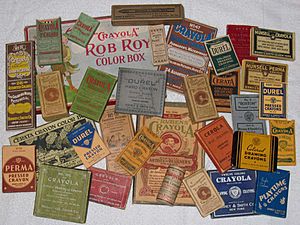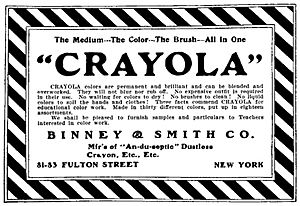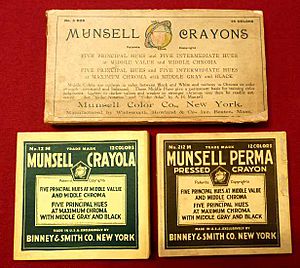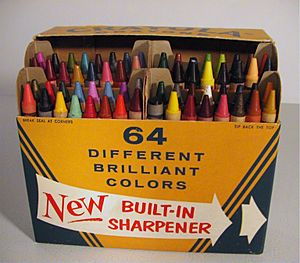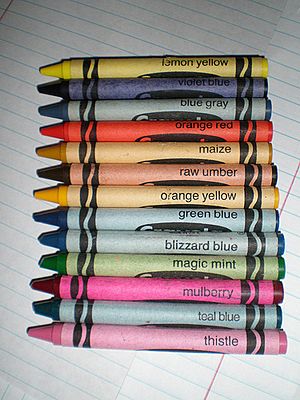History of Crayola crayons facts for kids
Since Crayola first introduced its drawing crayons in 1903, over 200 different colors have been made. Crayola became very popular because the company found a way to mix paraffin wax with safe colors cheaply. The crayon line has changed a lot over the years, especially in 1935, 1949, 1958, and 1990. Many special crayons have also been created, adding to the main Crayola collection.
Contents
The First Crayola Colors: 1903
After making colors for businesses for many years, Binney & Smith created their first crayon, the black Staonal Marking Crayon, in 1902. The next year, the company decided to sell drawing crayons to everyone. The name Crayola was suggested by Alice Binney, wife of company founder Edwin Binney. She combined craie, which is French for "chalk," with -ola, meaning "oily," because the crayons were made from wax.
At first, Crayola was just one of many brands made by Binney & Smith. Other crayons had names like Cerola and Durel. But the Crayola brand was the most successful. It came in two types: Crayola Gold Medal School Crayons for schools and "Rubens" Crayola Artists' Crayons for artists.
Early Crayola ads talked about 30 different colors, but there wasn't an official list. We actually know of 38 different crayons from this time. The biggest box was No. 51, called Crayola Young Artists' Drawing Crayons, which had 28 colors. Other colors were found in different boxes, like the "Rubens" No. 500, a 24-crayon set. The names of some crayons changed from box to box. Bigger sets often used names like those for oil paints. In fact, early Crayola ads often described drawing with crayons as a type of painting.
Over time, simpler names became popular. Several colors were stopped by 1910, including Light and Dark Venetian Red. The use of "Purple" instead of "Violet" ended around 1914. After 1915, Gold, Silver, and Copper were no longer in crayon sets, but you could still buy them in large amounts.
| Color | Name | Hexadecimal in their website depiction | Notes |
|---|---|---|---|
| Red | #ED0A3F | ||
| English Vermilion | #CC474B | Also spelled "Vermillion." | |
| Madder Lake | #CC3336 | ||
| Permanent Geranium Lake | #E12C2C | Discontinued by 1910. | |
| Indian Red | #CD5C5C | Same color as "Chestnut" (1999–present). | |
| Dark Venetian Red | "Venetian Red, Dark" on labels. Discontinued by 1910. | ||
| Venetian Red | #C80815 | ||
| Light Venetian Red | "Venetian Red, Light" on labels. Discontinued by 1910. | ||
| Orange | #FF8833 | ||
| Gold Ochre | "Golden Ochre" on some labels. Same color as "Maize" (1958–1990). | ||
| Medium Chrome Yellow | #FCD667 | Same color as "Medium Yellow" (1903–1958) and "Goldenrod" (1958–present). | |
| Yellow | #FFFF00 | ||
| Olive Green | #B5B35C | ||
| Light Chrome Yellow | On labels "Chrome Yellow, Light." Same color as "Light Yellow" (1903–1958) and "Lemon Yellow" (1903–1910, 1958–1990). | ||
| Light Chrome Green | "Chrome Green, Light" on labels. Same color as "Light Green" (1903–1935). | ||
| Green | #008001 | ||
| Medium Chrome Green | "Chrome Green, Medium" on labels. Same color as "Medium Green" (1903–1939). | ||
| Dark Chrome Green | #01786F | "Chrome Green, Dark" on labels. Same color as "Dark Green" (1903–1949) and "Pine Green" (1958–present). | |
| Blue | #2EB4E6 | Same color as "Celestial Blue" (1930–1949) and "Azure Blue" (1949–1958). | |
| Prussian Blue | Same color as "Midnight Blue" (1958–present). | ||
| Cobalt Blue | #0047AB | ||
| Celestial Blue | #4997D0 | Discontinued by 1910. | |
| Ultramarine Blue | #4166F5 | ||
| Purple | #6A0DAD | "Violet" from about 1914. | |
| Permanent Magenta | #F653A6 | Same color as "Magenta" (1903–present). | |
| Rose Pink | #FF66CC | Same color as "Pink" (1903–1917) and "Carnation Pink" (1958–present). | |
| Burnt Sienna | #E97451 | ||
| Van Dyke Brown | #664228 | Same color as "Brown" (1903–1935). | |
| Flesh Tint | #FFCBA4 | Same color as "Flesh" (1949–1956, 1958–1962), "Pink Beige" (1956–1958), and "Peach" (1962–present). | |
| Burnt Umber | #8A3324 | ||
| Raw Umber | #826644 | ||
| Raw Sienna | #D68A59 | Discontinued by 1910. | |
| Gold | #A57C00 | Metallic; swatch represents nominal hue only. Available only in bulk after 1915. | |
| Silver | #AAA9AD | Metallic; swatch represents nominal hue only. Available only in bulk after 1915. | |
| Copper | #B87333 | Metallic; swatch represents nominal hue only. Discontinued in 1915. | |
| Black | #000000 | ||
| Charcoal Gray | Discontinued in 1910. | ||
| White | #FFFFFF |
Munsell Crayola: 1926–1944
In 1926, Binney & Smith bought the Munsell Color Company's crayon line. These crayons were based on the Munsell color system, a way of organizing colors created by Albert Henry Munsell. This was the first time Crayola crayons used the idea of a color wheel.
The Munsell color wheel had five "main colors" (red, yellow, green, blue, and purple). It also had five "in-between colors" (yellow red, green yellow, blue green, blue purple, and red purple). Each color was available in two forms: "maximum chroma" (very bright) or "middle value and middle chroma" (more muted).
Three different crayon sets were sold:
- A box of seven: The five main colors at their brightest, plus Middle Gray and Black.
- A box of twelve: The five main colors in both bright and muted forms, plus Middle Gray and Black.
- A box of twenty-two: All the main and in-between colors in both bright and muted forms, plus Middle Gray and Black.
The Munsell color wheel inspired Binney & Smith to create a similar color wheel for Crayola crayons in 1930. Their wheel had six main colors (red, orange, yellow, green, blue, and violet) and six in-between colors (red-orange, yellow-orange, yellow-green, blue-green, blue-violet, and red-violet). This made a 12-color wheel. These were combined with Black, Neutral Gray, White, and Brown to make a 16-color box.
Munsell Crayola boxes were stopped in 1935. However, the crayons were still made in special Crayola boxes until 1944. This was because World War II caused shortages of many pigments needed to make crayons. Munsell crayons were not made again after the war. But the idea of the color wheel, started by Munsell, stayed a key part of Crayola until 1990.
The Munsell colors are shown in the table below.
| Color | Name | Hexadecimal | Notes |
|---|---|---|---|
| Maximum Red | #D92121 | ||
| Middle Red | #E58E73 | ||
| Middle Yellow Red | #ECB176 | Same color as "Medium Orange" (1949–1958). | |
| Maximum Yellow Red | #F2BA49 | ||
| Middle Yellow | #FFEB00 | ||
| Maximum Yellow | #FAFA37 | ||
| Maximum Green Yellow | #D9E650 | ||
| Middle Green Yellow | #ACBF60 | ||
| Maximum Green | #5E8C31 | ||
| Middle Green | #4D8C57 | ||
| Middle Blue Green | #8DD9CC | ||
| Maximum Blue Green | #30BFBF | ||
| Middle Blue | #7ED4E6 | ||
| Maximum Blue | #47ABCC | ||
| Maximum Blue Purple | #ACACE6 | ||
| Middle Blue Purple | #8B72BE | ||
| Maximum Purple | #733380 | ||
| Middle Purple | #D982B5 | ||
| Maximum Red Purple | #A63A79 | ||
| Middle Red Purple | #A55353 | ||
| Middle Grey | #8B8680 | Spelled "Grey" on labels, but "Gray" on boxes. Same color as "Neutral Grey" (1930–1956), "Gray" (1956–present). | |
| Black | #000000 | References to "Maximum Black" are erroneous. |
Crayola Colors: Changes Through 1949
From 1930 to 1935, Binney & Smith improved the Crayola lineup. They stopped making some colors and changed others. They also added the Munsell colors into their regular collection. In 1939, the company released the No. 52 set, which had 52 colors. This included all the Munsell colors and almost all other crayons made at the time.
Even though it was the biggest Crayola set yet, the No. 52 didn't get much attention. It was only made for about five years. In 1944, during World War II, there were shortages of the pigments needed for many colors.
When full production started again in 1949, Binney & Smith removed most of the Munsell colors. They also got rid of colors that were too similar to others. The new collection was based on the 12-color Crayola wheel, which was first created in the 1930s. Even though new crayons were added, the total number of colors went down to 48. The No. 52 box was officially replaced by the new No. 48 set, which contained all the colors being made then.
Many older crayons were removed from the Crayola line. However, several new colors were added. These new colors were light, medium, and dark shades of the main and in-between colors. This made the collection very organized. For ten years, the No. 48 box was Crayola's largest set. For many decades after, it remained a key part of the Crayola line.
| Color | Name | Hexadecimal | Notes |
|---|---|---|---|
| Red | #ED0A3F | ||
| Dark Red | #8B0000 | Same color as "Maroon" (1958–present). | |
| Indian Red | #CD5C5C | Same color as "Chestnut" (1999–present). | |
| Red-Orange | #FF4500 | ||
| Orange | #FF8833 | ||
| Medium Orange | #ECB176 | Same color as "Middle Yellow Red" (1926–1949). | |
| Yellow-Orange | #FFAE42 | ||
| Gold Ochre | Same color as "Maize" (1958–1990). | ||
| Medium Yellow | #FCD667 | Same color as "Medium Chrome Yellow" (1903–1910) and "Goldenrod" (1958–present). | |
| Yellow | #FFFF00 | ||
| Olive Green | #B5B35C | ||
| Light Yellow | #FFFFE0 | Same color as "Lemon Yellow" (1903–1910, 1958–1990). | |
| Yellow-Green | #9ACD32 | ||
| Dark Green | #013220 | Same color as "Forest Green" (1958–present). | |
| Light Green | #90EE90 | Same color as "Sea Green" (1958–present). | |
| Green | #01A368 | ||
| Light Turquoise Blue | Same color as "Aquamarine" (1958–present). | ||
| Turquoise Blue | #00FFEF | ||
| Middle Blue-Green | #0095B7 | Same color as "Blue-Green" (1958–present). | |
| Blue-Green | #0D98BA | Same color as "Maximum Blue" (1926–1949) | |
| Azure Blue | #4997D0 | Same color as "Blue" (1903–1935) and "Celestial Blue" (1930–1949). | |
| Cerulean Blue | #2A52BE | ||
| Prussian Blue | #003153 | Same color as "Midnight Blue" (1958–present). | |
| Blue | #0066FF | ||
| Medium Blue | #0000CD | Same color as "Blue" (1935–1949). | |
| Cobalt Blue | #0047AB | ||
| Blue-Violet | #8A2BE2 | Same color as "Violet-Blue" (1958–1990). | |
| Violet | #7F00FF | Same color as "Blue-Violet" (1958–present). | |
| Medium Violet | #65315F | ||
| Lavender | #B57EDC | ||
| Brilliant Rose | |||
| Medium Red-Violet | #BB3385 | Same color as "Orchid" (1958–present). | |
| Medium Rose | |||
| Light Magenta | #FF80FF | Same color as "Thistle" (1958–1999). | |
| Red-Violet | #C71585 | ||
| Magenta | #FF00FF | Same color as "Permanent Magenta" (1903–1914). | |
| Rose Pink | #FF66CC | Same color as "Carnation Pink" (1958–present). | |
| Carmine Red | #FF0038 | Same color as "Carmine" (1935–1949). | |
| Salmon | #FA8072 | ||
| Mahogany | #C04000 | ||
| Burnt Sienna | #E97451 | ||
| Brown | #964B00 | ||
| Flesh | #FFCBA4 | Same color as "Flesh Tint" (1903–1949), "Pink Beige" (1956–1958), and Peach (1962–present). | |
| Raw Umber | #826644 | ||
| Silver | #AAA9AD | Metallic; swatch represents nominal hue only. | |
| Black | #000000 | ||
| Neutral Gray | #8B8680 | Same color as "Middle Grey" (1926–1949), "Gray" (1956–present). | |
| White | #FFFFFF |
Crayola No. 64: A Big Change
The Crayola No. 64 box came out in 1958. It was Binney & Smith's largest regular set for over 30 years. This set brought the last big changes to Crayola colors before 1990. The famous flip-top box held 64 crayons in four rows of 16. The rows were raised so it was easier to grab the crayons. The box also had a crayon sharpener built into the back.
A few colors from the No. 48 box were stopped at this time. However, most were kept, sometimes with new names. Several new crayons were added to the set. This included six new "in-between" colors. This made the Crayola color wheel grow from 12 to 18 colors.
| Color | Name | Hexadecimal | Notes |
|---|---|---|---|
| Red | #ED0A3F | ||
| Maroon | #C32148 | Same color as "Dark Red" (1949–1958) | |
| Brick Red | #CB4154 | ||
| Indian Red | #CD5C5C | Same color as "Chestnut" (1999–present). | |
| Orange-Red | #FF681F | One of eight colors "retired" in 1990. | |
| Bittersweet | #FE6F5E | ||
| Burnt Orange | #CC5500 | ||
| Red-Orange | #FF4500 | ||
| Orange | #FF8833 | ||
| Yellow-Orange | #FFAE42 | ||
| Maize | #F2C649 | Same color as "Gold Ochre" (1903–1958). One of eight colors "retired" in 1990. | |
| Orange-Yellow | #F5BD1F | One of eight colors "retired" in 1990. | |
| Goldenrod | #DAA520 | Same color as "Medium Chrome Yellow" (1903–1910) and "Medium Yellow" (1903–1958). | |
| Yellow | #FFFF00 | ||
| Green-Yellow | #F1E788 | ||
| Spring Green | #ECEBBD | ||
| Olive Green | #B5B35C | ||
| Lemon Yellow | #FFF44F | Same color as "Light Yellow" (1903–1958). One of eight colors "retired" in 1990. | |
| Yellow-Green | #9ACD32 | ||
| Forest Green | #228B22 | Same color as "Dark Green" (1949–1958). | |
| Sea Green | #2E8B57 | Same color as "Light Green" (1949–1958). | |
| Green | #008001 | ||
| Pine Green | #01796F | Same color as "Dark Chrome Green" (1903–1910) and "Dark Green" (1903–1949). | |
| Light Blue | #ADD8E6 | Discontinued in 1958; replaced by Turquoise Blue. | |
| Aquamarine | Same color as "Light Turquoise Blue" (1949–1958). | ||
| Sky Blue | #76D7EA | ||
| Blue-Green | #0095B7 | Same color as "Middle Blue Green" (1949–1958). | |
| Cornflower | #93CCEA | ||
| Green-Blue | One of eight colors "retired" in 1990. | ||
| Navy Blue | #0066CC | ||
| Midnight Blue | Same color as "Prussian Blue" (1903–1958). | ||
| Blue | #0066FF | ||
| Cadet Blue | #A9B2C3 | ||
| Periwinkle | #C3CDE6 | ||
| Violet-Blue | Same color as Blue-Violet (1930–1958). One of eight colors "retired" in 1990. | ||
| Blue-Violet | #6456B7 | Same color as "Violet" (1949–1958). | |
| Violet | #8359A3 | On labels "Violet (Purple)". | |
| Brilliant Rose | Discontinued in 1958; replaced by Magenta. | ||
| Plum | #8E3179 | ||
| Orchid | #E29CD2 | Same color as "Medium Red-Violet" (1949–1958). | |
| Thistle | Same color as "Light Magenta" (1949–1958). "Retired" in 1999. | ||
| Mulberry | "Retired" in 2003. | ||
| Red-Violet | #BB3385 | ||
| Lavender | #FBAED2 | ||
| Carnation Pink | #FFA6C9 | Same color as "Rose Pink" (1903–1958). | |
| Violet-Red | #F7468A | ||
| Salmon | #FF91A4 | ||
| Mahogany | #CA3435 | ||
| Melon | #FEBAAD | ||
| Burnt Sienna | #E97451 | ||
| Brown | #AF593E | ||
| Sepia | #9E5B40 | ||
| Raw Sienna | #D27D46 | ||
| Tan | |||
| Peach | #FFCBA4 | Same color as "Flesh Tint" (1903–1949), "Flesh" (1949–1956, 1958–1962), and "Pink Beige" (1956–1958). | |
| Apricot | #FDD5B1 | ||
| Raw Umber | #826644 | One of eight colors "retired" in 1990. | |
| Gold | #A57C00 | Metallic; swatch represents nominal hue only. | |
| Silver | #AAA9AD | Metallic; swatch represents nominal hue only. | |
| Copper | #B87333 | Metallic; swatch represents nominal hue only. | |
| Black | #000000 | ||
| Gray | #8B8680 | Same color as "Neutral Gray" (1926–1956). | |
| Blue-Gray | #6699CC | One of eight colors "retired" in 1990. | |
| White | #FFFFFF |
Crayola Colors: 1958–1990
The first changes to the No. 64 box happened in its first year. Light Blue and Brilliant Rose were replaced by Turquoise Blue and Magenta. After that, no colors were replaced until 1990. However, in 1963, the color "Flesh" was officially renamed "Peach." This change happened partly because of the Civil Rights Movement. Crayola understood that not all people have the same skin color. The color "Flesh" had been called "Flesh Tint" until 1949. It was also called "Pink Beige" from 1956 to 1958. In 1962, the flesh-colored crayon was not included in a special box because Crayola felt it was not fair to everyone.
The 1970s brought Crayola's first special crayons. These were eight fluorescent colors that glowed under black light. They were never added to the No. 64 box. Instead, you could buy them separately or in a special box of 72 crayons. These often came with activity books or crayon stands. Fabric crayons were introduced in 1980. This showed that the Crayola brand was growing beyond just regular drawing crayons. Colored pencils and markers came next.
Crayola Colors: 1990–Present
The year 1990 saw the first big changes to Crayola drawing crayons in over 30 years. Eight colors were "retired into the Crayon Hall of Fame." Eight new colors were introduced. Then, 16 more colors were added in 1993, and 24 more in 1998. Five colors were replaced between 2000 and 2003.
The first big change was replacing eight colors that had been part of Crayola for a long time. These were:
- Orange-Red (made since 1958)
- Maize (formerly Gold Ochre, made since 1903)
- Orange-Yellow (1958)
- Lemon Yellow (formerly Light Yellow, made since 1903)
- Green-Blue (1958)
- Violet-Blue (made as Blue-Violet from 1930 to 1958)
- Raw Umber (1903)
- Blue-Gray (1958)
With these colors gone, the Crayola color wheel went from 18 to 14 colors. It now had six "main colors" and eight "in-between" colors. The eight new colors were: Vivid Tangerine, Dandelion (later retired in 2017), Jungle Green, Teal Blue (later retired in 2003), Cerulean, Royal Purple, Fuchsia, and Wild Strawberry.
In late 1992, Binney & Smith released the Crayola No. 96 Big Box. It had the 64 existing colors, plus 16 fluorescent crayons. It also had 16 unnamed colors. The names for these were chosen in a national contest. The winners were announced the next year. They included: Macaroni and Cheese, Asparagus, Granny Smith Apple, Shamrock, Tropical Rain Forest, Robin's Egg Blue, Pacific Blue, Denim, Purple Mountains' Majesty, Wisteria, Cerise, Razzmatazz, Tickle Me Pink, Mauvelous, Tumbleweed, and Timberwolf.
In 1996, a special color called Blue Ribbon was made. It celebrated the production of 100 billion Crayola crayons since 1903. Crayons of this color were in "limited edition" versions of the No. 96 box that year. But it did not become a regular color. The next year, four bright colors were added: Sunset Orange, Caribbean Green, Vivid Violet, and Pink Flamingo. These were then added to the regular lineup. In 1997, another contest was held to name eight new colors. These were added to sets the next year: Torch Red (later “Scarlet” in 1998), Banana Mania, Mountain Meadow, Outer Space, Purple Heart, Brink Pink (later “Pink Sherbet” in 2005), Fuzzy Wuzzy Brown, and Shadow.
In 1998, Crayola introduced its first 120-count set. Besides the existing colors, 12 more were added to make the total of regular and fluorescent crayons 120. These were: Canary, Fern, Manatee, Blue Bell, Eggplant, Cotton Candy, Cranberry (later “Blush” in 2005), Pig Pink, Beaver, Desert Sand, Almond, and Antique Brass (a metallic crayon). In the same year, Torch Red became Scarlet.
In 1999, Indian Red, a color since 1903, was renamed Chestnut. This was because children might think the color referred to the skin color of Native Americans, instead of a reddish pigment from India. Thistle, which was originally Light Magenta in 1949, was replaced by Indigo.
To celebrate 100 years of Crayola Crayons in 2003, a special 100-count box was made. It added four new colors to the existing 96-color box. Like in 1992 and 1996, the names were chosen in a contest. The four new crayons became part of the No. 96 box at the end of the anniversary year. The new colors were: Mango Tango, Inchworm, Wild Blue Yonder, and Jazzberry Jam. To make space for them, four other crayons were retired. These included two of the 16 fluorescent colors (Magic Mint and Blizzard Blue), plus Mulberry (made since 1958) and Teal Blue (introduced in 1990). Crayola fans could vote online to save one of five colors nominated for retirement. The winner was Burnt Sienna.
Three colors got new names in 2005. Brink Pink became Pink Sherbet, Cranberry became Blush, and Fuzzy Wuzzy Brown was shortened to Fuzzy Wuzzy. Since these changes, the Crayola lineup has stayed mostly the same. Changes have mostly been to special crayons.
On March 31, 2017, Crayola announced it would retire Dandelion. It would be replaced with a new blue color. People voted, and on September 14, 2017, the new crayon color's name was announced as "Bluetiful." This crayon color was included in boxes for sale starting in late January 2018.
The table below shows all the standard colors added since 1990.
| Color | Name | Hexadecimal in their website depiction | Notes |
|---|---|---|---|
| Scarlet | #FD0E35 | Introduced in 1998. Same color as "Torch Red" (1998). | |
| Sunset Orange | #FE4C40 | Introduced in 1997. | |
| Vivid Tangerine | #FF9980 | Introduced in 1990. | |
| Macaroni and Cheese | #FFB97B | Introduced in 1993. Also found as "Macaroni & Cheese" and "Macaroni-n-Cheese". | |
| Mango Tango | #E77200 | Introduced in 2003. | |
| Banana Mania | #FBE7B2 | Introduced in 1998. | |
| Dandelion | #FED85D | Produced 1990–2017. | |
| Canary | #FFFF99 | Introduced in 1998. | |
| Inchworm | #AFE313 | Introduced in 2003. | |
| Asparagus | #7BA05B | Introduced in 1993. | |
| Granny Smith Apple | #9DE093 | Introduced in 1993. | |
| Fern | #63B76C | Introduced in 1998. | |
| Shamrock | #33CC99 | Introduced in 1993. | |
| Mountain Meadow | #1AB385 | Introduced in 1998. | |
| Jungle Green | #29AB87 | Introduced in 1990. | |
| Caribbean Green | #00CC99 | Introduced in 1997. | |
| Tropical Rain Forest | #00755E | Introduced in 1993. | |
| Robin's Egg Blue | #00CCCC | Introduced in 1993. | |
| Teal Blue | #008080 | Produced 1990–2003. | |
| Outer Space | #2D383A | Introduced in 1998. | |
| Pacific Blue | #1CA9C9 | Introduced in 1993. | |
| Cerulean | #02A4D3 | Introduced in 1990. | |
| Denim | #1560BD | Introduced in 1993. | |
| Bluetiful | #3C69E7 | Introduced in 2017. | |
| Wild Blue Yonder | #A2ADD0 | Introduced in 2003. | |
| Indigo | #4B0082 | Introduced in 1999. | |
| Manatee | #979AAA | Introduced in 1998. | |
| Blue Bell | #A2A2D0 | Introduced in 1998. | |
| Purple Heart | #69359C | Introduced in 1998. | |
| Royal Purple | #7851A9 | Introduced in 1990. | |
| Wisteria | #C9A0DC | Introduced in 1993. | |
| Vivid Violet | #9F00FF | Introduced in 1997. | |
| Purple Mountains' Majesty | #9678B6 | Introduced in 1993. Also found as "Purple Mountain Majesty" and "Purple Mountain's Majesty." | |
| Fuchsia | #C154C1 | Introduced in 1990. | |
| Pink Flamingo | #FC74FD | Introduced in 1997. | |
| Jazzberry Jam | #A50B5E | Introduced in 2003. | |
| Eggplant | #614051 | Introduced in 1998. | |
| Cerise | #DE3163 | Introduced in 1993. | |
| Wild Strawberry | #FF43A4 | Introduced in 1990. | |
| Cotton Candy | #FFBCD9 | Introduced in 1998. | |
| Razzmatazz | #E3256B | Introduced in 1993. | |
| Pig Pink | #FDDDE6 | Introduced in 1998. Also called "Piggy Pink." | |
| Blush | #DE5D83 | Same color as "Cranberry" (1998–2005). | |
| Tickle Me Pink | #FC89AC | Introduced in 1993. | |
| Mauvelous | #EF98AA | Introduced in 1993. | |
| Pink Sherbert | #F78FA7 | Same color as "Brink Pink" (1998–2005). | |
| Fuzzy Wuzzy | #CC6666 | Same color as "Fuzzy Wuzzy Brown" (1998–2005). | |
| Beaver | #9F8170 | Introduced in 1998. | |
| Tumbleweed | #DEAA88 | Introduced in 1993. | |
| Desert Sand | #EDC9AF | Introduced in 1998. | |
| Almond | #EFDECD | Introduced in 1998. | |
| Shadow | #8A795D | Introduced in 1998. | |
| Timberwolf | #D9D6CF | Introduced in 1993. | |
| Antique Brass | #CD9575 | Introduced in 1998. Metallic; swatch represents nominal hue only. |
The Crayola Color Wheel
1926: 10 Colors
The idea of a color wheel first came to Crayola crayons when Binney & Smith bought the Munsell line in 1926. Munsell's color system had five "main colors" and five "in-between colors." This made a color wheel with ten colors. The main colors were red, yellow, green, blue, and purple. The in-between colors were yellow red, green yellow, blue green, blue purple, and red purple. Each color was available in a very bright version or a more muted version. The table below shows all the main and in-between colors at their brightest.
| Color | Name |
|---|---|
| Maximum Red | |
| Maximum Yellow Red | |
| Maximum Yellow | |
| Maximum Green Yellow | |
| Maximum Green | |
| Maximum Blue Green | |
| Maximum Blue | |
| Maximum Blue Purple | |
| Maximum Purple | |
| Maximum Red Purple |
1930: 12 Colors
In 1930, Binney & Smith started using the color wheel idea for their own crayons. They added orange as a main color. They based the other colors on their existing crayons, not the Munsell ones. This created a 12-color wheel that fit well with the regular Crayola lineup.
| Color | Name |
|---|---|
| Red | |
| Red-Orange | |
| Orange | |
| Yellow-Orange | |
| Yellow | |
| Yellow-Green | |
| Green | |
| Blue-Green | |
| Blue | |
| Blue-Violet | |
| Violet | |
| Red-Violet |
Adjustments in 1935 and 1949
The only big changes to the Crayola color wheel between 1930 and 1958 happened in 1935 and 1949. In 1935, the original blue was replaced with a darker shade. In 1949, a new version of violet was introduced.
| Color | Name |
|---|---|
| Blue (1903) | |
| Blue (1935) | |
| Violet (1930) | |
| Violet (1949) |
1958: 18 Colors
In 1958, Binney & Smith launched the No. 64 box. This brought many changes to the existing colors. It also included a major update to the color wheel, which grew from 12 to 18 colors. The six in-between colors were doubled, so there were now two in-between colors between each of the main colors. The blue from 1935 was replaced with a brighter color. A new, darker blue-green replaced the old one. The 1930 version of violet returned, while the 1949 violet became blue-violet. The original blue-violet became violet-blue.
The 1958 color wheel was a key part of Crayola crayons until 1990. In 1990, four of the colors were stopped: orange-red, orange-yellow, green-blue, and violet-blue. Without these colors, the Crayola color wheel now has 14 colors. There are two colors between yellow and green, and two between violet and red. But there is only one color between the other main colors.
| Color | Name |
|---|---|
| Red | |
| Orange-Red | |
| Red-Orange | |
| Orange | |
| Yellow-Orange | |
| Orange-Yellow | |
| Yellow | |
| Green-Yellow | |
| Yellow-Green | |
| Green | |
| Blue-Green | |
| Green-Blue | |
| Blue | |
| Violet-Blue | |
| Blue-Violet | |
| Violet | |
| Red-Violet | |
| Violet-Red |


